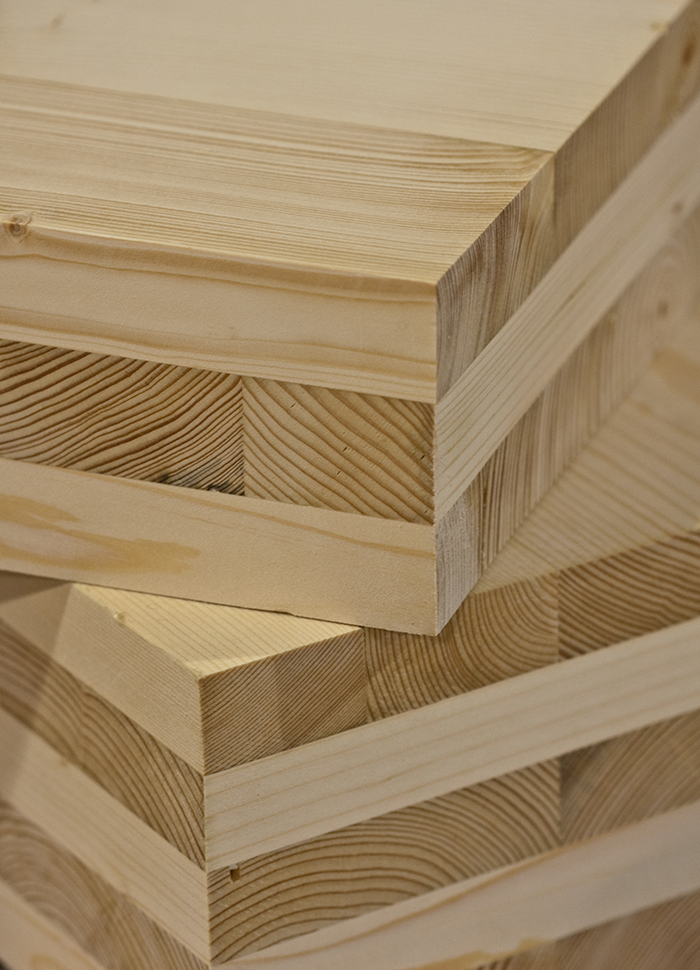
Cross-laminated timber panels. Image: Structurlam
By Jack Nissen
Capital News Service
Steel and concrete would be the classic choices for building a large new laboratory planned at Michigan State University.
But experts in the university’s forestry department are asking, “Why not wood?”
They’re not the only ones with that question as builders nationwide push to build high rises, college laboratories and other large buildings with a construction material typically seen in houses. It’s a trend that could bring new markets for Michigan trees, fight climate change and produce new jobs, experts say.
“We have a tremendous amount of resources here,” said Jon Fosgitt, a member of the Forest Stewards Guild in Michigan. “The challenge is understanding the construction style, but also creating the infrastructure here in the state. We’ve got the resources here and that’s a Michigan-made story.”
Building with wood isn’t new. But a hot new construction technique called cross-laminated timber–CLT, for short–makes it possible to build large buildings out of wood. It’s constructed by bonding several layers of wood panels in alternating directions. The result is a material strong enough to build skyscrapers.
It’s fire resistant as well, said David Neumann, the Department of Natural Resources (DNR) forest marketing specialist. “It has the same strength as concrete, when designed properly.”
Michigan has the trees. But there’s more to it than that to put them to work.
“Here’s the challenge with cross-laminated timber- there’s only two plants in the U.S. that construct it and they are both on the western side of the country,” Fosgitt said. It doesn’t make sense to construct the materials, then ship them across the country when we have all of those resources right here, he said.
One solution is to build a plant here, but even as interest in using cross laminated timber construction grows, it’ll take time for the industry to grow with it.
“I think it’s been taken up quite quickly, considering that there wasn’t even manufacturing in the US recently,” said Jennifer Cover, the president of WoodWorks. “We’re actually seeing it take off at an exponential rate. It’s quite incredible.”
WoodWorks is a nonprofit organization funded by the wood industry and offers free education and design assistance related to non-residential and multi-family wood buildings.
Even so, the only large construction project considering the use of cross-laminated timber in the state is on Michigan State’s campus.
While the technique is recognized by the 2015 International Building Code, a model that addresses safety and health concerns of buildings, it’s still not the industry standard.
Fosgitt does anticipates a stronger emphasis on training people to build with wood, especially in Michigan.
In fact, one of the strongest drivers for more wood buildings is an environmental one. Wood products store atmospheric carbon, a greenhouse gas that warms the planet. Concrete and steel do not. According to the Journal of Sustainable Forestry, substituting wood could prevent 14 to 31 percent of carbon dioxide emissions from entering the atmosphere.
“Obviously the environmental benefits are good because climate change is real,” Fosgitt said. “This is part of a natural solution to climate change.”
Fears of a fire hazard may make wood a less popular choice. But cross-laminated timber doesn’t burn like normal wood because it’s so dense. It also has a faster installation process than concrete or steel, Cover said.
It’s particularly popular on the West Coast due to its flexibility and ability to withstand earthquakes, Fosgitt said. The first all-wood high rise was approved in Portland, Oregon, last June.
While Michigan has no structures built from cross-laminated timber, it does have the Superior Dome at Northern Michigan University in Marquette, the largest wooden dome in the world. Construction started in 1989 and used large laminated beams, said the university’s associate athletic director, Carl Bammert. It opened in 1991.
The DNR has teamed up with WoodWorks to help train more Michigan builders and architects.
The organization also offers assistance on other wood-building techniques that have been around for longer, like timber that’s put together with nails and glue.
It hosted training sessions for architects and engineers in Grand Rapids and Ann Arbor in September. The next step is to get more cross-laminated timber for Michigan builders to work with.
“In the long run, what we’d like to get is a facility to make some of these products out of Michigan wood,” said Richard Bowman, the director of government relations at the Nature Conservancy in Michigan.
Fosquitt said that if the mass timber industry were to make its way to Michigan, it would put more pressure on the forest resource. But, because Michigan harvests only a fraction of its annual growth, the industry can be managed sustainably.
“And when a building is made from natural products, it smells great too.”
Meanwhile, the newest wall covered by ivy at MSU may not necessarily be brick or concrete.
“MSU has been considering using CLT and other engineered wood products for the new building that is planned,” Richard Kobe, the chair of the university’s forestry department, wrote in an email.